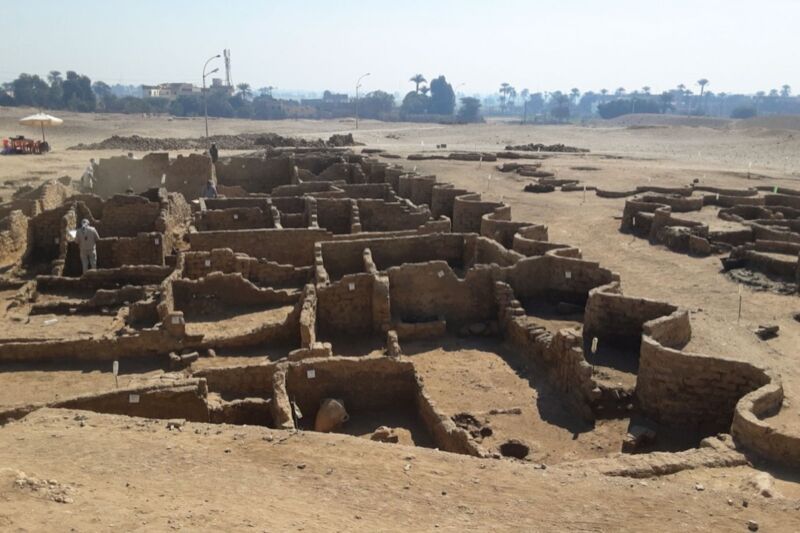An ancient Egyptian Pompeii —
It’s the “second most important archaeological discovery since the tomb of Tutankhamun.”
Jennifer Ouellette
–

Enlarge / Egyptian archaeologists have discovered a 3400-year-old city just outside Luxor, dating back to the reign of Amenhotop III, grandfather to King Tut.
Zahi Hawass
A team of Egyptian archaeologists has unearthed what some describe as an industrial royal metropolis just north of modern-day Luxor, which incorporates what was once the ancient Egyptian city of Thebes (aka Waset). The archaeologists dubbed the site “the lost golden city of Luxor,” and they believe it may have been devoted to manufacturing decorative artifacts, furniture, and pottery, among other items.
Hieroglyphic inscriptions found on clay caps of wine vessels at the site date the city to the reign of the 18th-dynasty pharaoh Amenhotep III (1386-1353 BCE), whose generally peaceful tenure was marked by an especially prosperous era, with Egypt at the peak of its international power. (Mud bricks at the site were also marked with Amenhotep III’s cartouche.) There are more surviving statues of Amenhotep III than any other pharaoh. He was buried in the Valley of the Kings, and his mummy was discovered in 1889. Analysis revealed that Amenhotep III died between 40 and 50 years of age, and he likely suffered from various ailments in his later years (most notably arthritis, obesity, and painful abscesses in his teeth).
The pharaoh’s eldest son and heir, Thutmose, died young, so the throne passed to his second son, Amenhotep IV, who soon changed his name to Akhenaten. (His queen was Nefertiti, and his son, who would eventually assume the throne, was the famous boy-king, Tutankhamun.) Akhenaten rejected the traditional polytheistic religion, dominated by the worship of Amun, and decided to start his own religion. He worshipped Aten instead (hence the name change) and would eventually try to suppress the worship of Amun entirely.
Akhenaten also moved the capital away from the city of Thebes, setting up a new capital on the site of what is now the city of Amarna, halfway between Thebes and Memphis. Was he a visionary revolutionary or a heretical, mad fanatic? Possibly neither—some historians have argued that moving the capital may have been more of a political strategy on the part of the new pharaoh to break the stranglehold of Amun’s priests on Egyptian culture and society. At any rate, Tutankhamun brought the capital to Memphis and ordered the construction of even more temples and shrines at Thebes once he assumed the throne, ending Akhenaten’s rebellion.
The discovery of this new site may or may not shed more light on Akhenaten’s decision to abandon Thebes—and this nearby newly discovered manufacturing center—but it is nonetheless being hailed as an extraordinary discovery. “There’s no doubt about it; it really is a phenomenal find,” Salima Ikram, an archaeologist who leads the American University in Cairo’s Egyptology unit, told National Geographic. “It’s very much a snapshot in time—an Egyptian version of Pompeii. I don’t think you can oversell it. It is mind-blowing.”
Betsy Bryan, an Egyptologist at Johns Hopkins University, called it “the second most important archaeological discovery since the tomb of Tutankhamun.”
The “lost golden city of Luxor” features mudbrick walls in a zig-zagging pattern.
Zahi HawassHieroglyphic inscriptions found on clay caps of wine vessels at the site helped archaeologists date the city.
Zahi HawassUnusual burial of a cow or bull, found inside one of the rooms in the city.
Zahi HawassAn excavated human skeleton.
Zahi HawassArchaeologists have found all kinds of decorative and ritual artifacts, such as scarabs and amulets.
Zahi HawassA ceramic jug.
Zahi HawassAnother artifact found at the site.
Zahi HawassA sampling of statuettes recovered from the site.
Zahi Hawass
Archaeologist Zahi Hawass, who led the Egyptian team, shared the official announcement in a Facebook post. The team started out searching for Tutankhamun’s mortuary temple, since temples of the last two pharaohs of the 18th dynasty, Horemheb and Ay, had been found in the same general area. The archaeologists chose an excavation area sandwiched between a temple of Rameses III at Medinet Habu and Amenhotep III’s temple at Memnon. Within weeks of beginning the excavation last September, Hawass and his team were excited to unearth mud brick formations: zigzagging walls as much as nine feet high, apparently a rare element in ancient Egyptian architecture.
The team found numerous artifacts: rings, scarabs, pottery vessels, debris from thousands of statues, and a large number of tools, possibly used for spinning or weaving and casting molds. There was a bakery and a food preparation area (with ovens and pottery for storage) in the southern part of the site that was large enough to serve a good-sized workforce. There was also a production area for mud bricks and what appears to be an administration area. One excavated area contained the skeleton of a cow or bull, while a human skeleton was found in an odd position: arms stretching down against its side, with the remains of a rope around its knees.
Finally, the team found a vessel holding roughly two gallons of what was once dried or boiled meat, inscribed with “Year 37.” It also revealed the names of two of the city’s inhabitants. The translated inscription, per Hawass, reads, “Dressed meat for the third Heb Sed festival from the slaughterhouse of the stockyard of Kha made by the butcher luwy.”
“As history goes, one year after this pot was made, the city was abandoned and the capital relocated to Amarna,” Hawass wrote. “But was it? And why? And was the city repopulated again when Tutankhamun returned to Thebes? Only further excavations of the area will reveal what truly happened 3,500 years ago.”
And he added this tantalizing note: “Work is underway and the mission expects to uncover untouched tombs filled with treasures.”
The archaeologists have already discovered a group of promising rock-cut tombs in a large cemetery to the north of the settlement.

